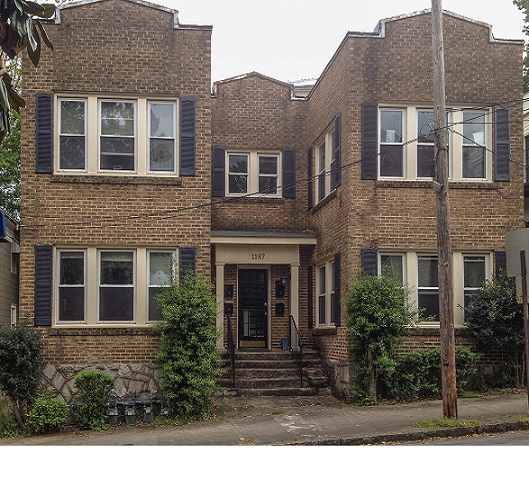Well first of all, if you’re looking at buying a multiplex for investment – good on you, you’ve clearly done something right!
But believe it or not, there’s serious competition for multiplexes – those properties with 3-or-more dwellings.
Cap rates are down, demand is high, and investors are accepting lower returns in order to get into the market.
Let me outline nine criteria that a would-be investor must consider, at the bare minimum, for any multiplex purchase…

Should I outline these in order?
Sure, I could try.
And by try, I mean that every investor has a different set of criteria, and my #4 might be somebody else’s #7.
Of course, you might have a #10, #11, and #12 to add to the list.
And all the while, many of these points go hand-and-hand.
So let me start from the top, where I find most of my clients see it…
–
1) Yield
This should be at the top of the list, no?
Some people would put #2 on the list, but I don’t think that’s smart in this market.
When you buy a stock, what are you looking for?
Well, I suppose that’s a terrible example, since everybody wants to watch the stock go up, up, and up, and they’re looking at the appreciation potential, with the “buy low, sell high” mentality.
But in the good ole days, investors were looking for dividends!
How much is the stock paying you to own it? You’re a shareholder; you own a portion of the company, so how much of the company’s profit are you receiving?
Times have changed, both in terms of the stock market, and the real estate market.
Ask the man on the street, and he’s looking to buy a stock for $10, and sell it for $15. But ask the pension funds, and they’re looking for a steady, consistent, predictable, safe return. They’re the savviest of investors, and they’re looking for a 6% return in perpetuity.
When it comes to investing in real estate, my personal belief is that if you forecast a zero percent appreciation, and the investment makes sense to you based on yield, then the investment will pay out and exceed your expectations.
There’s that old adage in real estate: “When is the best time to sell a piece of real estate?”
The answer: “Never.”
Life happens, situations change, and more often than not, even a long-term investor will need or want to sell.
But on a long-enough time horizon, the appreciation is the icing on the cake, and where the investor makes, by far, the most money.
But at the onset, the short and immediate-term numbers have to make sense.
What does that mean? What kind of numbers are we looking at in this market?
I see multi-unit dwellings selling at 3% cap rates, and I can’t make sense of it.
When I got into real estate 5.5-6% cap rates on multi-unit properties were the norm. Over time, those figures have dropped, and it’s up to the investor to decide what works.
2) Appreciation Potential
I suppose the “yield” section was just the preamble for some people.
Every time I talk about yield, and give the example of the dividend-paying-stock, people tell me, “This isn’t 1880; you’re not buying paper-shares of the Great Pacific.”
Fair point. Times change.
But I’m conservative by nature, and when it comes to buying multi-unit dwellings for long-term investing, I would argue until I’m blue in the face that you have to consider appreciation potential after yield.
Over the last few years, it’s been easy to refute my argument.
I’ve told this story before, so you long-time readers might remember it…
Back in 2010, I had an investor-client in from Los Angeles, who was looking at purchasing a couple of 4-5 unit dwellings.
He was primarily concerned with yield, and the financing ability of the properties (which we’ll explore below), and truly believed, despite his desire to buy, that prices in Toronto were likely headed for a dip.
We found a property in Queen West that was perfect, and hit on several of the other points listed below as well.
It was around a 5.25% cap rate at the list price, and although it would be slightly cash-flow negative each month based on his downpayment, he was willing to consider it.
The property didn’t have an “offer night” as is the custom today, but it still received four offers, and sold for $100,000 over the list price.
My client told me, “This makes no sense. This is simply the greater fool theory; whoever is buying this property, is expecting to sell it to somebody else down the line for more.”
He wasn’t wrong, logically.
But in practice, he was proven tragically incorrect.
That property, listed at $1.2M, that sold for $1.3M, recently sold for over $2M.
Now tell me again – what’s more important: yield or appreciation potential?
And am I naive to say “appreciation is just icing on the cake?”
3) Location
How can you have any list about real estate evaluation criteria without location?
Location is all part and parcel of the overall evaluation.
Some investors would choose a superior location over a better return, and I wouldn’t disagree.
Earlier this year, I sent a client the listing for a turnkey 4-plex in Mimico, with a rare 4.8% cap rate, what I perceived to be below-market rents, and a copy of the inspection – which looked fantastic.
My client responded with a 3-word email: “It’s in Mimico.”
Enough said.
I liked the income, I liked potential for more income, and I loved the condition of the property. But he would have rather had a property with a 3.5% cap rate, steps to Trinity-Bellwoods, and at the risk of sounding cliche, “To each, their own.”
Toronto is a rapidly-growing city, both in terms of the population and the urban sprawl, but also in the eyes of the world.
For investors thinking long-term, the best appreciation will undoubtedly be found with those properties that are closest to the city centre, as is the case with every world-class city. But those properties will have substantially lower yields.
It’s up to the buyer to decide where the best value, for he or she, ultimately lays.
4) Condition
Have you ever looked at the “financials” for an income-property listed on MLS?
It’s hilarious.
You’re lucky if you get property taxes, water, and gas. Sellers and listing agents love to pretend like electricity and insurance don’t exist. They’ll be really quick to tell you about the $25 per month the property generates in basement coin-laundry, but they’ll n-e-v-e-r detail the overall cost of ongoing maintenance, upkeep, and repairs.
Part of the reason why many Toronto real estate investors have turned toward condos in the past few years (aside from the lower cost) is because of the maintenance of an 80-year-old 4-plex. You can do the most thorough of home inspections, and find the property is in A++ shape, but you’ll still be opening your wallet for something, every few months.
As with everything else above, the condition of the property has to be taken into consideration with the other criteria. You might be willing to pay more, and accept a lower yield, for a true “turnkey” income property. Or you might decide to pay less, do the work yourself, and hope to add value.
Of course, you can always combine this with #5…
5) Market Rents
Just a brief point to make here, but an important one.
Many properties are being sold with tenants attached, who are leasing at rents well below fair market value.
If properties are sold based on capitalization rates, those rates are taking current rents into consideration, and those rents are below FMV, then it goes without saying that the property is under-valued.
Yes, it can be difficult to get a tenant out so you can raise the rent, and it’s going to become tougher thanks to the Ontario Fair Housing Plan. But tenants don’t stay forever.
And if you have a property that needs work and has below market rents, when the tenants vacate, you can put work into the property to increase the rents, and add value at the same time.
6) Size & Scope
What do you for a living?
What’s your personal life like?
Tell me about your family…
Now tell me if you would be able to manage a 5-unit property that’s a 45-minute drive in traffic, with whatever knowledge, skill, and capability you currently possess.
Buying a 5-plex is one thing, but managing it is another.
There’s the ongoing maintenance and upkeep, the supervising of tenants, the collection (and chasing…) of rents, and the search for new tenants.
Savvy investors know how to make the property, and the tenants, work for them. Many landlords will offer a tenant a nominal sum (start with the basement tenant and $30…) to take out the garbage every week. Many landlords will “allow” the tenants to paint, provided it’s in a neutral colour, and done well. I put “allow” in quotes, of course, because it’s value-add for the landlord to have a fresh coat of paint, and yet many tenants believe it’s a privilege.
Some investors do this full time – they buy, manage, and maintain multi-unit dwellings. They have the time, and the experience, to do so.
Other investors have no clue what they’re doing, and they either know that in advance, or find out very quickly!
The fee to manage a property varies drastically, but you’re looking at 5% of gross rents as a starter. If you can’t handle the size and scope of the property, then factor that cost into your initial financial analysis.
7) Ability To Finance
There’s no hard-and-fast rule on this, but most mortgage brokers will tell you:
4-Units – residential financing
5-Units – there might be a lender out there that will provide residential financing
6-Units – this is commercial, without a doubt
I’ve had clients in the past purchase 5-unit properties and obtain residential financing, but lending criteria changes like the direction of the wind. More often than not, it depends on which lender you’re talking to, and which underwriter is handling the file. I’ve seen the 5-unit properties fall into a serious grey area over the years, as some underwriters will lend with residential criteria, and some won’t.
And keep in mind – we’re talking about downpayment and rate!
To buy a 3-plex, you simply need to meet the minimum downpayment criteria (used to be 5%, now it’s 20% for a “second property” subject to some exceptions), and you can obtain a current residential rate, ie. a 5-year, fixed-rate of 2.49%.
When you get into 6-plex and above, you may be required to put down 35%, and the rates could be into the 4-6% range. Yes, that’s a wide range, but as I said – it depends on your mortgage broker, and which lenders and underwriters they’re talking to.
Going from a 4-unit property, with a 20% down payment, and 2.49% interest rates, to 6-unit property, and a 35% down payment, with a 4.49% interest rate, can be tough to swallow.
But keep in mind, not all “investors” are taking on debt. Some are buying in cash, some take on debt because it’s cheap (ie. 4.49% is less than their rate of expected return in other investment vehicles), and thus it’s not really a “problem” per se for those looking to buy 6-plexes and up.
You might also argue the yield is better as you climb in the number of units. Clearly a duplex offers a lower rate of return than a 6-plex, not only because there’s more demand, but because it’s cheaper, easier to afford for the average investor, and thus the price gets bid up.
Ultimately the ability to finance will come into play for an overwhelming majority of investors, and so you might actually start with this.
8) Tenants
Wow, we’re really starting to see how all of these points are intertwined.
The size and scope of the property, combined with the location, combined with the market rents, will ultimately dictate what type of tenants you’ve got.
An investor-client of mine once told me, “Basement apartments aren’t worth the hassle.”
I asked what he meant, and he said, “They’re not worth the $600 they bring in each month.”
Now, this was a long time ago, hence the $600 figure. Maybe the hassle has been lessened over the years as rents have increased.
But he elaborated in saying, “Ask yourself – what kind of person rents a sh!tty basement apartment for $600 per month? The lowest common denominator of society, that THAT is now one of my partners in my financial endeavor.”
Sensitivities aside, he might not be wrong.
I’m sure some of the most wonderful people in the world have rented basement apartments, but on the whole, the person looking for the absolutely lowest-priced rental in the city does so not out of desire, but out of necessity.
This client went on to tell me that most of the tenants he’s had renting basements have been troublesome, sometimes in terms of their character and how they treat the unit, but primarily in terms of their ability to service the rent.
Personally, I think if you’re an investor running multi-unit dwellings, there’s a learning curve, and you’ll figure out how to deal with tenants – at every rent level. And with basement apartments going for $800, $900, or $1,000 in the city, who can turn that kind of money down?
Ultimately, the type of property you have, plus the location, will determine what kind of tenants you get.
And if you’re looking at a property that is tenanted, you want to know everything you can about the tenants in place.
I’ve seen some really sharp listing agents put together info packages on the tenants themselves – their income, occupation, FICO scores, duration of tenancy, and frequency of payments. That goes a long way toward marketing the property to investors.
9) Proximity To Transit
Perhaps this falls into the “location” category, but having already flushed that out, I think this deserves its own point.
Transit in Toronto is just God-awful, as we all know.
And without generalizing too much here, dare I say that many people who rent, also take transit.
The market rent will be affected by the proximity to transit, the yield will be affected by the market rent, and once again, we see how these points are intertwined.
You could suggest that proximity to parks, schools, retail, etc. bear consideration, but I don’t put them anywhere near the level of importance as transit. This is my generalization – about renters taking transit, and you can disagree if you want to. But I’m speaking from experience, with what my clients see out there.
–
You’re probably looking for a point #10, but this list isn’t meant to be well-rounded; it’s meant to point out the most important criteria when evaluating a multiplex for investment.
Somewhere within these points lays a happy medium for the investor.
And as we know, every investor is different.































Condodweller
at 8:59 am
Finally a good article. Before I invested in real estate I found an article by a well-respected investor whose #1 metric was the gross rent to price ratio. He recommended not to invest in any property where the price is more than seven times annual gross rent. Obviously you will not find a property like that in the GTA. However, I have also heard from other investors that if you treat your RE investment as an investment, you should have someone manage it for you and factor in the management fee. As soon as you do that, the property can be anywhere in Canada. All of a sudden you can find a suitable property.
Dave
at 9:20 am
I don’t understand why investors deal with the hassle of tenants, the unpredictability of repairs, and the disposal costs/efforts to sell when they can get a similar return on Choice REIT (Loblaws), CAPREIT properties, or other reasonable safe investments. If you need your cash out, simply sell the shares on the market – no 5.65% commission, instantaneous access to the money.
Now if multiplexes could yield 10+% then it would be worth the hassle!
A
at 10:30 am
Dave, just saying:
1) Investing in REITs is not necessarily low risk either. There have been poorly managed REITs where people have lost their shirts.
2) Generally, REIT properties are not necessarily residential properties. Residential properties are a different animal from commercial properties.
3) Perhaps some situations are not purely commercial. People might buy a multiplex with the intention to live in one of the units… or they might lease out all the units at the beginning with some intention down the road to occupy.
4) it is not possible to have as much leverage when buying a REIT unit. It is possible to perhaps get 80% of the purchase price financed for a multiplex, whereas you will not be able to get the same 80% in the form of a margin loan.
Condodweller
at 3:28 pm
#3 is a good point however the article title says for investment which I take to mean no owner occupancy. WRT #4 strictly speaking you are right, however, no reit buys their properties for cash therefore with the combination of their mortgage plus your margin you can probably leverage 100% or even more.
Geoff
at 3:49 pm
I also suspect (rightly or wrongly) that it’s a question of sourcing capital – I think it’s easier to borrow to buy an investment property than it is to borrow $250K to invest in REIT’s, no?
Ralph Cramdown
at 4:51 pm
I could borrow $250k to invest in REITs in about the time it is taking me to write this comment. I’m guessing that arranging a mortgage for a fourplex would probably take at least a week.
Condodweller
at 4:54 pm
A reit is an already leveraged investment, sorry if I wasn’t clear in my other response. As for sourcing funds, that’s actually another benefit of investing in a reit as you can start with as low as a single share plus commission which should be around $20 and the sky is the limit. WRT to raising the funds in the first place, if one can’t source $250k perhaps that’s an indication that one shouldn’t be making the investment in the first place.
Ralph Cramdown
at 4:44 pm
“Below market rent”
https://thewalrus.ca/the-rise-and-fall-of-torontos-classiest-con-man/
The great thing about buying a place with below market rents is that, when you get disgusted with it a few years down the road, you can use that as a selling feature! Me, I don’t even pay hydro. My landlord has the unit all wired up with a meter for when the next tenant moves in, though. I think it was installed about six or eight years ago.
JDF
at 9:48 pm
Other criteria to consider:
Separate Hydro Meters – its not just the saving you the cost of hydro but more so on the behavior specifically abuse or apathy when someone else is paying the bill.
Legal triplex, fourplex, multi-plex – there are lots of multi-unit dwellings in Toronto that are not legal and not done to code. This usually presents an issue with the mortgage and property insurance.
My experience with basement renters – they are usually pretty easy going and not very particular. Basement rents in downtown Toronto will command $1,200 – $1,300 so usually that is someone who is gainfully employed.
Distance from you – agreed that if you are going to pay someone to manage it, the property can be anywhere. If you are going to manage it yourself along with your day job and family life – make sure to stick to a 2 km radius to where you live – it will save you time, money, frustration and you will be able do drive by`s regularly just to make sure nothing is amiss.
The Future – I think as some of us become part of the sandwich generation, taking care of our parents and having kids at home – a multi-plex dwelling can become quite useful. If you are thinking of investing in one, consider what you might need in the future…..perhaps 2 bedroom units versus 1 beds or bachelors. Perhaps close to transit and walking distance to a grocery store or coffee shop – therefore, everyone can be independent versus relying on a car or for you to drive them around. Our multiplex is downtown and contains 2 units with 3 bed and 2 baths (1500 square feet) each – the size of the units sealed the deal for us – a contingency in case we ever need it.
Long Time Realtor
at 8:08 am
Interesting stat I pulled from TREB this morning. In May of 2016 there were 10 sales of freehold properties over $5million. This May there were 30!
Ralph Cramdown
at 9:24 am
“If properties are sold based on capitalization rates, those rates are taking current rents into consideration, and those rents are below FMV, then it goes without saying that the property is under-valued.”
Can we classify this as technically true in the Platonic sense, but probably not true in the Toronto market? The city has many small-time multi-unit properties and many small-time landlords, in a population full of real estate lust. Most of those landlords understand the difference between market rents and the current rent roll, and set their cap rate targets accordingly. You’re not bidding against a bunch of dummies.
Points to ponder:
– If a long term tenant moves out, you’re going to have to paint. And maybe freshen the kitchen and bathroom. You are probably looking at one month’s vacancy, if you are organized and have good trades, and aren’t looking for the type of tenant who needs to move in mid month. If you want to show the unit to prospective tenants in its renovated state, you may be looking at two months. Add the reno and vacancy costs, divide by the difference between the old and new tenants’ rents, and tell me how many months it takes just to break even on where you’d have been if the old tenant stayed. “But I improved the place and raised the rents!” you say. Yes, but if you bought the place based on your new and improved cap rate, you’ve already paid for those improvements in the purchase price.
– The further below market rents your current tenants’ rents are, THE LESS LIKELY THEY ARE TO MOVE. Somebody paying $100 below market might move at the drop of a hat, but if your tenant is paying $800 below market, you better hope they get a great job offer in Alberta or discover they’re expecting twins. Beyond a certain age, you’re basically waiting for them to die.
Condodweller
at 9:48 am
“Beyond a certain age, you’re basically waiting for them to die.” Gee what a cheerful thought Ralph!
It’s funny but I did look at a multiplex outside the GTA recently and one of the tenants was home at the time. She was over 90 and I was told by the agent that she is a great long term tenant who had been there for 30 years. Being a pragmatic person my first thought was that’s great, but how much longer will she be there, following your thought, and the second was what do I do, not if, but when she passes in the apartment. I suppose these are the cases where a property manager is worth every penny unless your day job is a mortician.
Ralph Cramdown
at 11:20 am
Just call 911, they’ll take care of everything. But dispose of the murder weapon first!
Daveyboy
at 6:04 pm
Used to be a landlord. Owning stocks that pay dividends is alot easier ,cheaper and tax effiecent.
chris
at 2:09 pm
This was a very practical article. Thank you for posting it.
I’m wondering who is the buyer for Toronto multiplex that is 100 years old and shows an ROI of only 3% when GIC’s are 3 %?
I have yet to see an honest or accurate rent tole from an agent as you referenced. They leave out a lot of cost elements and nobody seems to account for cost of vacancy or leasing it out. Not a single deal I;ve seen makes sense on paper yet people bid them up.
I’m thinking these people have other income, don’t require the ROI or ROE, won;t be maintaining anything and they’ll look for somebody else to overpay in 3 years when they sell. Its October 2018 at present and banks are cutting the income in half and requiring 40% down at present. They aren’t allowing anything for the finished and rented basement. There’s a new law looking to get passed where Ontario landlord s can;t raise the rent after somebody leaves and you’ve renovated. You therefore can’t recognize any upside. This would serve to devalue all income property and force people to buy reits or invest outside Ontario.
Olivia Watson
at 10:01 pm
Really Interesting I‘d like to talk to you more about this 647-501-4165
adeel khan
at 6:38 am
Yes the evaluation is always important, I have evaluated a real estate project that is https://sohnisaiban.com/ when I was looking to invest
Audrey Berend
at 12:58 pm
What do you think about Tottenham for an area? There’s an amazing 4 plex there. 6269 4th line
Is that too far from the city?